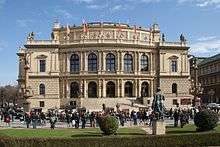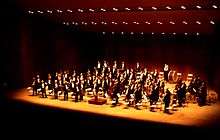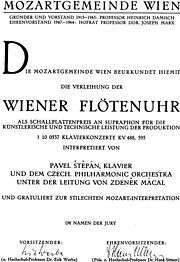Czech Philharmonic
| Czech Philharmonic | |
|---|---|
| Orchestra | |
 Rudolfinum | |
| Founded | 1896 |
| Concert hall | Rudolfinum |
| Principal conductor | Jiří Bělohlávek |
| Website |
www |


The Česká filharmonie (Czech Philharmonic) is an internationally renowned Czech symphony orchestra based in Prague.[1] The orchestra's principal concert venue is the Rudolfinum.
History
The name "Czech Philharmonic Orchestra" appeared for the first time in 1894, as the title of the orchestra of the Prague National Theatre.[1] It played its first concert under its current name on January 4, 1896 when Antonín Dvořák conducted his own compositions, but it did not become fully independent from the opera until 1901. The first representative concert took place on October 15, 1901 conducted by Ludvík Čelanský, the first artistic director of the orchestra.[1] In 1908, Gustav Mahler led the orchestra in the world premiere of his Symphony No. 7. The orchestra first became internationally known during the principal conductorship of Václav Talich, who held the post from 1919 to 1931, and again from 1933 to 1941. In 1941, Talich and the orchestra made a controversial journey to Germany, where they performed Bedřich Smetana's My Country in a concert enforced by the German offices.[1]
Subsequent chief conductors included Rafael Kubelík (1942–1948), Karel Ančerl (1950–1968), Václav Neumann (1968–1989), Jiří Bělohlávek (1990–1992), Gerd Albrecht (1993–1996), Vladimir Ashkenazy (1996–2003), Zdeněk Mácal (2003–2007),[2] and Eliahu Inbal (2009–2012). In the wake of the Velvet Revolution, the orchestra reorganised in 1991 and controversially voted to appoint Gerd Albrecht its new chief conductor and to dismiss Bělohlávek. Instead of remaining until Albrecht's accession, Bělohlávek resigned from the orchestra in 1992.[3] In December 2010, the orchestra announced the reappointment of Bělohlávek as chief conductor, beginning in 2012,[4] with an initial contract of 4 years.[5] The orchestra can be seen recording Dvořák's Cello Concerto with Julian Lloyd Webber and their principal conductor Václav Neumann on the film Dvořák - In Love?
Past principal guest conductors of the orchestra have included Sir Charles Mackerras. Manfred Honeck is the orchestra's current principal guest conductor.
The Czech Philharmonic's first phonograph recording dates from 1929, when Václav Talich recorded My Country for His Master's Voice. It recorded on the Supraphon label during the Soviet era.

Honours and awards
The Czech Philharmonic has won many awards, ten Grand Prix du Disque de l'Académie Charles Cros, five Grand Prix du disque de l'Académie française and several Cannes Classical Awards. The Czech Philharmonic was nominated for Grammy Awards in 2005, and also two Wiener Flötenuhr awards, with Pavel Štěpán, Zdeněk Mácal and Václav Neumann (1971 and 1982)( Supraphonline ). It was voted 20th place of the top 20 best orchestras in the world in a 2008 survey by Gramophone magazine.[6]

Chief Conductors
|
|
|
References
- 1 2 3 4 Černušák, Gracián; Štědroň, Bohumír; Nováček, Zdenko, eds. (1963). Československý hudební slovník I. A-L (in Czech). Prague: Státní hudební vydavatelství. p. 203.
- ↑ Matthew Westphal (2007-09-11). "Angry Over Bad Review, Conductor Zdenek Mácal Abruptly Quits Czech Philharmonic". Playbill Arts. Retrieved 2007-09-13.
- ↑ John Rockwell (1992-12-30). "Czech Philharmonic Faces Perilous Times In Dividing Country". New York Times. Retrieved 2012-03-24.
- ↑ "Šéfdirigentem České filharmonie bude Jiří Bělohlávek". ČTK (in Czech). ČeskéNoviny.cz. Retrieved 26 January 2011.
- ↑ "Bělohlávek to become Czech Philharmonic's chief conductor in 2012". Prague Daily Monitor. 2010-12-23. Retrieved 2012-03-24.
- ↑ Ben Hoyle (2008-11-21). "LSO is only British orchestra in list of world's best". Times Online. London. Retrieved 2009-01-23.
Sources
- Sláma, František (2001). Z Herálce do Šangrilá a zase nazpátek ("From Heralec to Shangrila and Back Again") (in Czech). Říčany: Orego. ISBN 80-86117-61-8.
- Karel Mlejnek (1996). Česká filharmonie (in Czech). Prague: Paseka.
- Vladimír Šefl (1971). Česká filharmonie (in Czech). Prague: Czech Philharmonic.
- Václav Holzknecht. Česká filharmonie. Příběh orchestru (in Czech). Prague: SHN.
External links
- Česká filharmonie official site
- František Sláma (musician) Archive: More on the History of the Czech Philharmonic between the 1940s and the 1980s. Reminiscences - Photographs - Sound Archive. Sections Czech Philharmonic Conductors, Part 1-3, Czech Philharmonic Instrumentalists. Václav Talich's players and the younger CPO generations, Czech Philharmonic in Documents
- Film of Czech Philharmonic in rehearsal
- Václav Talich recording Dvorak Slavonic Dances with the Czech Philharmonic in 1955 More about this recording